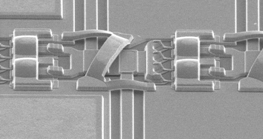DARPA amplifier circuit achieves speeds of 1 trillion Hz, enters Guinness World Records
October 29, 2014
Officials from Guinness World Records have recognized DARPA’s Terahertz Electronics program for creating the fastest solid-state amplifier integrated circuit ever measured: one terahertz (1012 Hz), or one trillion cycles per second — 150 billion cycles faster than the existing world record set in 2012.
“This breakthrough could lead to revolutionary technologies such as high-resolution security imaging systems, improved collision-avoidance radar, communications networks with many times the capacity of current systems, and spectrometers that could detect potentially dangerous chemicals and explosives with much greater sensitivity,” said Dev Palmer, DARPA program manager.
Developed by Northrop Grumman Corporation, the Terahertz Monolithic Integrated Circuit (TMIC) exhibits power gains (amplification) several orders of magnitude beyond the current state of the art by using a super-scaled 25 nanometer gate-length indium phosphide high electron mobility transistor.
The TMIC showed a measured gain (on the logarithmic scale) of nine decibels at 1.0 terahertz and eight decibels at 1.03 terahertz. “Nine decibels of gain is unheard of at terahertz frequencies” said Palmer. “This opens up new possibilities for building terahertz radio circuits.”
By contrast, current smartphone technology operates at one to two gigahertz and wireless networks at 5.7 gigahertz.
For years, researchers have been looking to exploit the high-frequency sub-millimeter-wave spectrum beginning above 300 gigahertz. Current electronics using solid-state technologies have largely been unable to access the sub-millimeter band of the electromagnetic spectrum due to insufficient transistor performance.
To address the “terahertz gap,” engineers have traditionally used frequency conversion—converting alternating current at one frequency to alternating current at another frequency—to multiply circuit operating frequencies up from millimeter-wave frequencies.
This approach, however, restricts the output power of electrical devices and adversely affects signal-to-noise ratio. Frequency conversion also increases device size, weight and power supply requirements.
